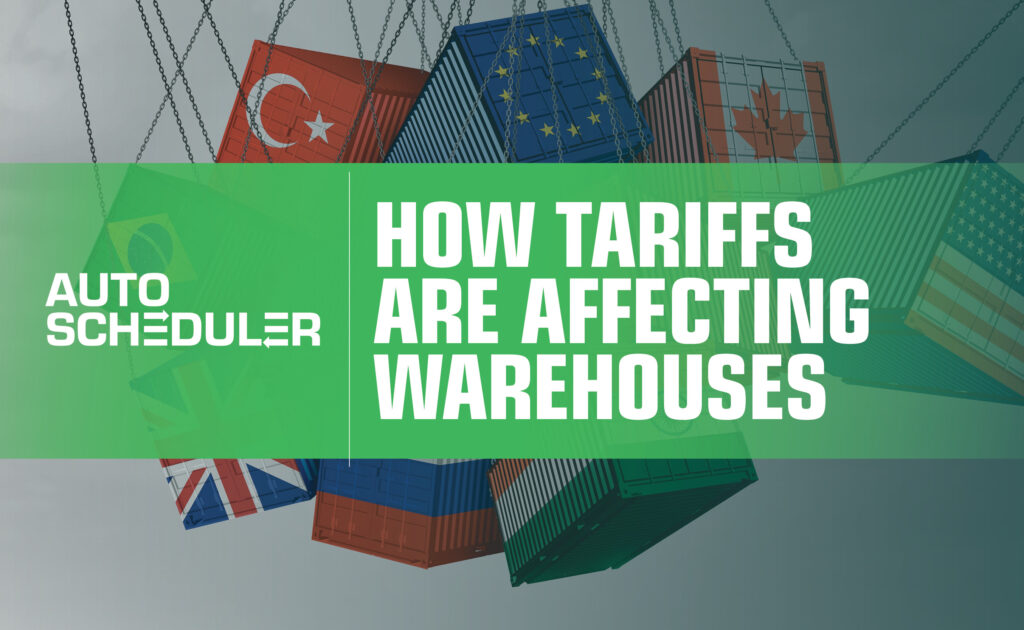Tariffs, or taxes imposed on imported goods, have long played a central role in regulating international trade and protecting domestic industries. However, in recent years, escalating trade wars have led to new tariffs on a wide range of goods. As these tariffs trickle through supply chains, warehouses worldwide feel the impacts significantly. The effects are complex and often unpredictable, from increased costs to shifts in storage strategies.
Most recently, tariffs on steel and aluminum are causing availability issues on small components used in manufacturing, including screws, nuts, bolts, nails, and wire. According to the Wall Street Journal, the U.S. doesn’t have the plants to churn out these critical components needed to displace imports – “Companies that use them say their customers won’t tolerate price increases, and contractors may delay projects until they learn how to blunt the effects of the new duties. About $178 billion worth of steel and aluminum products are subject to the 25% tariff, more than three times more than the imported products affected by the original 2018 tariffs on them. Aimed at closing loopholes that officials said undermined the 2018 levies, the enlarged tariff pushes up the cost of a 10-cent screw to 17 cents for an importer, companies say.”
Twenty-five percent tariffs on cars, light-duty trucks, and certain auto parts imported into the U.S. will go into effect on April 2, 2025. Other tariffs imposed since Trump took office include 20% tariffs on Chinese goods, limited 25% tariffs on goods from Canada and Mexico, and increased 25% tariffs on steel and aluminum. These tariffs will impact more than $1 trillion in imports.
One of the most immediate effects of tariffs is the rising cost of imported goods. When tariffs are imposed, the price of affected goods increases, forcing companies to either absorb the higher costs or pass them on to consumers. This presents a financial challenge for warehouses, which often operate on thin profit margins.
Warehouses that handle high volumes of imported goods have been particularly vulnerable. Increased costs mean reduced profitability unless companies adjust their pricing strategies. Additionally, warehousing facilities that rely on imported materials for construction or maintenance are feeling the pinch. Steel, aluminum, and other construction materials subjected to tariffs have become more expensive, which impacts expansion plans and maintenance budgets.
Shifts in Inventory Management Strategies
Many companies have altered their inventory management strategies in response to tariff-related price hikes. Some have resorted to stockpiling goods before tariffs take effect, increasing demand for warehousing space. This trend was especially evident during periods of heightened trade tension between the U.S. and China. Fearing supply chain disruptions or further price hikes, companies opted to store more significant quantities of goods than usual.
However, the stockpiling strategy has drawbacks. Increased inventory requires additional space, labor, and management. For warehouses already operating at near-full capacity, accommodating higher inventory levels means expanding facilities or renting additional space, which increases costs.
AutoScheduler helps address challenges caused by tariffs by optimizing inventory placement within the warehouse. It ensures goods are stored in the most efficient spots to minimize retrieval times and reduce handling costs. By automating the allocation of storage locations based on factors like demand frequency and space availability, AutoScheduler reduces the operational burden of handling large, fluctuating inventories. It maximizes space utilization, which is especially valuable when warehouses operate at or near full capacity.
Impact on Automation and Technology Adoption
As warehouses grapple with higher costs due to tariffs, many are turning to automation and advanced technologies to improve efficiency and reduce expenses. Automated systems, such as AutoScheduler, can optimize workflows, streamline operations, and enhance productivity, thereby helping offset some of the financial pressures brought about by tariffs.
AutoScheduler streamlines scheduling and routing, allowing warehouses to handle higher volumes of goods with the same or fewer resources. Its automated task generation and prioritization reduce the need for manual intervention, decreasing labor costs and making the warehouse more cost-effective.
Technological advancements are also aiding in predictive analytics, allowing companies to anticipate fluctuations in demand better and adjust inventory levels accordingly. This capability is crucial in a tariff-impacted environment where companies must adapt to changing market conditions.
Supply Chain Diversification
Tariffs have prompted many companies to reconsider their supply chains, seek alternative suppliers, or relocate manufacturing operations to avoid tariff-heavy regions. This shift has direct implications for warehousing, as changes in supply chains often necessitate adjustments to storage locations and distribution strategies.
Some companies have diversified their supplier base to minimize dependency on regions subject to high tariffs. As a result, warehouses must adapt to new product lines, different packaging standards, and varying transportation requirements. Flexibility and adaptability have become essential qualities for warehousing operations in a tariff-affected world.
AutoScheduler helps warehouses manage the increased complexity of tariffs. It enables seamless integration of new suppliers and products, ensuring that incoming goods are efficiently processed and stored without disrupting ongoing operations.
Regional Warehousing and Reshoring Trends
Another noticeable trend is the increase in regional warehousing as companies move to reduce dependency on foreign suppliers. By relocating storage facilities closer to end consumers or production sites, companies can mitigate the effects of tariffs and improve supply chain resilience.
Reshoring—bringing manufacturing and warehousing operations back to the home country—has gained traction in recent years. This strategy is particularly appealing to companies seeking to avoid tariffs altogether. However, reshoring presents its own challenges, including higher labor costs and logistical complexities. For warehouses, it means adjusting infrastructure, reevaluating workflows, and potentially investing in new technology to remain competitive.
Implications for Warehouse Staffing
The impact of tariffs extends beyond inventory management and logistics and affects staffing. As companies strive to cut costs, many are turning to automation to reduce their reliance on manual labor. However, the transition is not always smooth. Implementing automated systems requires investment and staff retraining, which can be costly and time-consuming.
Additionally, tariffs can indirectly influence labor availability. For example, tariffs on imported materials used in construction can slow down new warehouse development, limiting job opportunities. In contrast, increased demand for warehousing space due to stockpiling may temporarily boost employment in certain regions.
Tariffs are profoundly reshaping the warehousing landscape. Rising costs, shifting inventory strategies, increased automation, supply chain diversification, and evolving staffing needs are all part of the broader picture. As companies continue to navigate the complexities of global trade, warehouses must remain agile, innovative, and adaptable to thrive.
In the future, the most successful warehouses will likely be those that can balance cost efficiency with flexibility, leveraging technology to stay ahead of shifting trade policies and market demands. While tariffs present undeniable challenges, they also offer an opportunity for the industry to rethink traditional practices and embrace new solutions.




